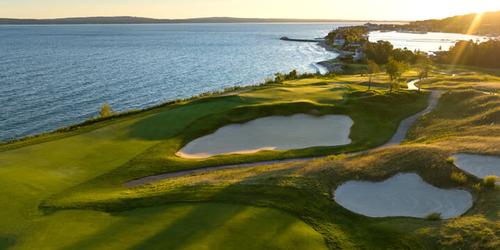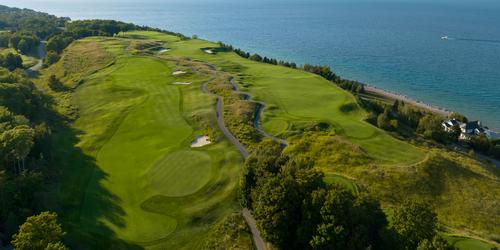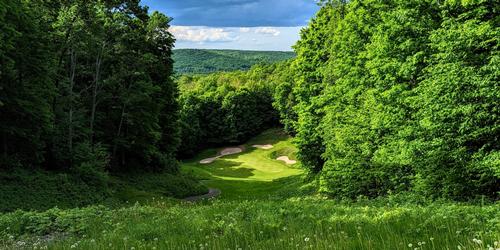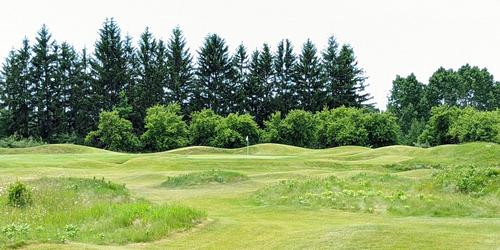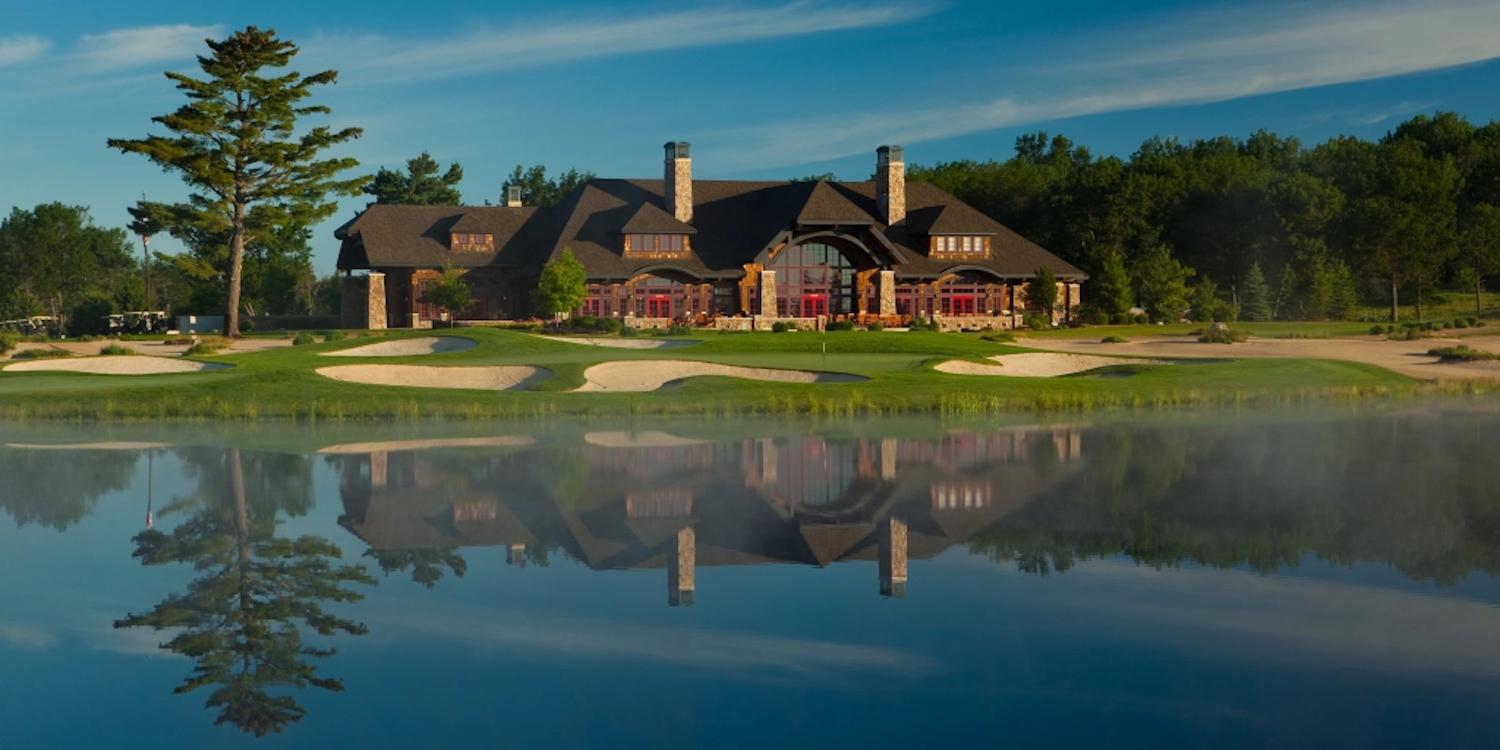
Forest Dunes, The Loop, and more! Destination golf in Roscommon, MI
By Kiel Christianson
Every once in a while, you pass through the entrance to a golf course or resort, and something suddenly changes. You feel the buzz and hum of the world die out behind you, and the destination envelops you in peacefulness. Erin Hills in Wisconsin is one of those places. I imagine Bandon Dunes in Oregon is, too.
In the Great Lakes Sate, there are hundreds of beautiful courses, and dozens of luxurious golf resorts, but of all the ones I've visited, Forest Dunes has, more than any other, the magical feel of complete and total golf nirvana. Mike Keiser, progenitor of Bandon Dunes and Sand Valley, once famously said something to the effect of, "One golf course is just a golf course. Two golf courses make a destination." Forest Dunes is now a full-fledged golf destination. And as the facilities keep expanding, it is arguably the best "pure golf" destination in "Pure Michigan."
Forest Dunes opened in 2002 as a private club, but has been fully public since 2011, when it was purchased by Arkansas trucking magnate Lew Thompson. The layout, which Tom Weiskopf has described as "one of my top-five all-time designs," can be played at five different lengths, from 7,116 yards all the way down to 4,993 yards. For purists, one of the most welcome aspects of the course is that - unlike most Northern Michigan tracks - it's extremely walkable. Forest Dunes doesn't have the lake views of Arcadia Bluffs, but the layout has been voted as the best in the state by multiple publications and is perennially ranked as one of the top 25 public courses in the nation.
In 2017, a second course opened at Forest Dunes-well technically, a second AND a third. The Loop debuted as the first, and only, fully reversable 18-hole championship course in the U.S. After playing this brilliant design, I would wager that several similar courses will be opening very soon, though, as it allows operators to maintain just one set of holes while offering two very different courses.
In 2020, The Bootlegger - a 10-hole "short course" designed by Keith Rhebb and Riley Johns opened. It's perfect for juniors, beginners, and anyone looking to squeeze some golf into a broader itinerary, with green fees of $49 for unlimited play (based on availability. The Bootlegger takes its name from the legend of The Purple Gang, Detroit-area gangsters who reportedly ran liquor from Canada through the area during Prohibition. Finally, a new putting course, the Hilltop Putting Course, occupies two acres of rolling terrain, is free to play and ideal for post-round putting contests.
With the addition of The Loop, Forest Dunes is a full-fledged destination. Luxurious accommodations are provided in the AuSable Lodge and golfers' villas (more on these later), and the food in the clubhouse ranks as some of the best I've ever tasted in Northern Michigan (more on that later, too). In 2020, a new par-3 course will open on the property as well. But let's begin with The Loop.
The Loop Red
Forest Dunes owner Lew Thompson long wanted a second course that would entice golfers to stay on the property longer - á la the golf destinations mentioned above. He also wanted a course concept that would "wow" him. World-famous golf course architect and Michigan native Tom Doak delivered a plan for a fully reversible course.
"The appeal of a reversible course is people would want to play it both ways. You are getting two golf courses in one," Doak said in a press release from August 4, 2014.
According to the press release, Doak said the idea of reversible course is not as revolutionary as it sounds. Many Scottish links, including The Old Course at St. Andrews, were played in reverse in winter to spread out the wear and tear of divots.
The term "one-of-a-kind" has been applied to countless golf resorts, but given the top-ranked status of Forest Dunes, and the uniqueness of The Loop, this one is fully deserving of the description.
The Loop switches playing directions every other day, and, amazingly, for the most part, it feels like you are playing two completely different courses. It is very difficult to identify fairways and greens from one day to the next. Only the 18th green is same playing both directions. On the Red Course, it's wide and shallow, with a pot bunker in the back. On the Black Course, it's deep and narrow, with the pot bunker on the left.
The Loop has a strong caddie corps, and players would be very wise to hire one, especially their first couple times around each "course." This design is like nothing I, or you, have played. It feels, sounds, and plays like a seaside links course, but it's here in the woods of Northern Michigan. The lines off the tees - which are simply three small flags stuck in the ground for each hole - are not at all obvious. Our caddie, Marcelo, told us where to aim. Sometimes we missed those lines badly and though we had lost our balls for sure. But Marcelo would almost always say, "You're fine there!" How he found those balls, I have no idea. It was uncanny.
The same goes for the approaches to the greens. Most of the time, Marcelo advised us to take less club than the yardage would indicate, given the course's firm, linksy character. Shots bounce and run quite a bit, and run-up shots to the amazingly contoured greens are preferred.
We played The Red Course first, from the 6,054-yard middle tees (back = 6,805, front = 5,006) and already at the green of the 551-yard, par-5 2nd hole, I was hooked. "This is the hardest green on the course," Marcelo said, as we gazed upon the putting surface, which is bisected by a deep trench I had to putt down into and back out of.
The greens of The Loop are the wildest I've ever seen: the aforementioned trench, yawning bunkers all around, crazy but mostly natural humps and mounds - and these various carnivalesque features appear in both directions, but provide utterly different experiences from one day to the next.
How does one pick out highlights on a course whose holes change from day to day? On the Red Course, the 125-yard 6th was maybe the most fun, with its benign distance but malignant bunkering. The 442-yard 8th is a cool dogleg downhill and back up to a green that seems to be floating in the air. And the green of the 185-yard 14th is perhaps the craziest green I've ever seen anywhere, yet somehow avoids feeling tricked up.
The Loop Black
"Good morning!" said Marcelo, whom we also engaged for our second round on The Loop. We could not imagine figuring out where to go and how to play the holes in the other direction without his skilled guidance. He kept asking, "Does it look like the Red Course? Do you recognize where you are?" My son and I just kept shaking our heads dumbly. With the exception of a couple of greens, it truly felt like we were on a completely different links. Doak has performed some incredible alchemy here. In a different era, they may have burned him as a witch.
My favorite two holes might have been the 414-yard 11th, which Marcelo described as "not long," although it plays uphill and was directly into the wind. A single sentinel pine and a deep pot bunker make for a difficult approach. The 381-yard 12th features the prettiest approach on the course, which is a downhill shot to a three-tiered green, with bunkers like mortar craters dotting the fairway and greenside.
From there, the back nine of the Black Course takes an evil turn two brutish long par-3s (#13, 222 yards; #15, 195 yards) bookend the 489-yard, par-4 14th. My son and I played these three holes in a combined 11-over, but you know what? We still had a blast.
The Black Course plays at 4,982 yards, 6,078 yards, and 6,704 yards from the front, middle, and back tees, respectively. Although modern-day recreational golfers might think a course of ~6,000 yards will be too easy, I recommend sticking with the middle tees for both the Red and Black. There are plenty of challenges and plenty of places to bomb a drive, no matter the yardage. Doak is a genius, and you will never feel bored or untested.
Forest Dunes
Tom Weiskopf may have listed Forest Dunes in the Top 5 of his designs, but it is #1 in my book. The design is characterized by generous landing areas, each portion of which poses subtly different challenges and angles toward the large, rumpled greens. The approaches into the greens are multifarious, and the greens themselves rank as some of the smoothest and purest I have ever been privileged to putt on. Tee boxes allow players to choose from five different yardages, ranging from 7,116 yards down to 4,993 yards. My 15-year-old son and I chose the II tees (6,550), but numbers reported here reflect the yardage from the tips.
On the tee of the 403-yard par-4 1st hole, the first-time visitor is presented with a classic resort-course opener: easy bogey, reasonable par, if the correct club and line are chosen for the sharp left-to-right dogleg. The 451-yard par-4 2nd is rated as the #1 handicap hole on the course, but is not all that difficult, as long as your drive moves a little right to left around the corner of a stand of pines.
By the 605-yard, par-5 5th hole, it becomes apparent why they named the course "Forest Dunes"-the moniker is not as contradictory as you may have imagined before arriving. The equally picturesque par-5 7th (dubbed "Goalposts") has all the bucolic charm of a par 3, with its green nestled into trees and ferns and sand.
Forest Dunes is one of those rare courses that keeps getting better on every hole. The 443-yard 8th may offer the prettiest approach on the course, with a marsh left, bunkers right, and the clubhouse and lodge behind the green.
After the turn, the interest level builds further. The 439-yard 10th hole (named "Decision"), with its forked fairway and forked green, might be the most memorable of all, as it's disorienting and delightful all at once.
A hallmark of Forest Dunes Golf Club is ever-present waste areas, from which the course derives its name. You see, just below the turf lie acre upon acre of sand, deposited millennia ago by receding glaciers. Not only does this mean the course drains beautifully, it also allowed Weiskopf to expose vast stretches of it create natural hazards. Just wait until you get to the 233-yard, par-3 16th and the drivable, risk-reward, 302-yard, par-4 17th-the type of hole Weiskopf became famous for. There is so much sand from tee to green on these holes, you'll feel like you're on some ocean-side course in Florida rather than deep in the Michigan woods.
Lake AuSable Lodge, Villas, and Cottages
Forest Dunes has evolved into an idyllic golf destination. The original course and The Loop provide three top-notch rounds. Toss in The Bootlegger and Hilltop Putting Course, and devoted golfers have enough entertainment for days.
In short, Forest Dunes represents a veritable golf theme park for golfers of all skill levels. Lake AuSable Lodge stands just 35 yards from the first tee of the original course, and the clubhouse restaurant offers excellent food and drink (the gourmet mac-n-cheese and the Forest Dunes burger are highly recommended, and the made-to-order breakfast sandwich is a pre-round must). Prices are surprisingly reasonable as well, considering the virtual monopoly they have. The back patio is one of the most peaceful post-round spots you'll find on any course, anywhere, so eat outside if the weather allows.
The Villas consist of 2- and 4-bedroom condos, ideal for buddy or family trips. My son and I frankly did not want to leave, we had grown so comfortable after just two nights in the princely digs. If you want even more space, or to spend extended time in this golf haven, there are 7 cottages (i.e., full-fledged houses) on site, which sleep from 4 to 8 people in total luxury. My son is already imagining buddy trips when he gets older, and this is now his ideal destination.
Indeed, there are few golf destinations as peaceful as Forest Dunes. As soon as you enter the grounds, the world melts away and you are enveloped in world-class golf. There is a rumor a third 18-hole course is in the planning stages. If true, there are some people-like me and my son-who will never want to go anywhere else.
Revised: 07/25/2023 - Article Viewed 3,108 Times
- View Course Profile
About: Kiel Christianson
![]() I’ve been a travel and golf writer for online and print publications for 25 years, including over 10 years with The Golf Channel. My blog on The Golf Channel websites began in 2003, making it one of the first in the golf world. Other publications include poetry, food and travel features, and research articles in the broad area of cognitive science.
I’ve been a travel and golf writer for online and print publications for 25 years, including over 10 years with The Golf Channel. My blog on The Golf Channel websites began in 2003, making it one of the first in the golf world. Other publications include poetry, food and travel features, and research articles in the broad area of cognitive science.
Follow Kiel Christianson:
Contact Kiel Christianson:
Midwestern Golf - Publisher
217-714-4561







